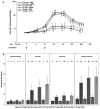AVIAN INFLUENZA VIRUS: THE NEXT PANDEMIC?
- PMID: 40771611
- PMCID: PMC12323483
AVIAN INFLUENZA VIRUS: THE NEXT PANDEMIC?
Abstract
Novel avian influenza viruses continue to circulate in animal species around the world and show a propensity to reassort and acquire virulence factors, which raises the concern that these viruses may adapt to humans. Pandemic preparedness has relied heavily on vaccine stockpiles. However, avian influenza strains genetically drift over time, and stockpiled vaccines often fail to elicit protective immunity for these genetic variants. Various strategies can help overcome immune imprinting and immunological hyporeactivity as well as broaden the immune response to variant viruses. Adjuvants remain a key strategy for improving the immunological response to avian influenza antigens. Today, three vaccines are approved in the United States for H5N1 influenza viruses though continued focus on surveillance and pandemic preparedness is essential to prepare for the possibility of human-to-human spread of this highly pathogenic influenza virus.
© 2025 The American Clinical and Climatological Association.
Figures





References
-
- Control CfD. H5 Bird Flu: Current Situation. Available at: https://www.cdc.gov/bird-flu/situation-summary/index.html .
Publication types
MeSH terms
Substances
LinkOut - more resources
Full Text Sources
Medical
